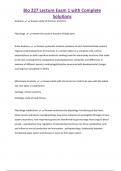Bio 227 Lecture Exam 1 with Complete
Solutions
Anatomy Answer-study of structure and form
Physiology Answer-the study of function of body parts
Gross Anatomy Answer-systematic anatomy (anatomy of each functional body system),
regional anatomy(examines all structures in a certain region as a complete unit), surface
anatomy(focus on both superficial anatomic markings and the interal body structures that relate
to the skin covering them), comparative anatomy(examines similarities and differences in
anatomy of different species), embryology(discipline concerned with developmental changes
ocurring from conceptoin to birth).
Microscopic Anatomy Answer-deals with structures too small to be seen with the naked
eye, two types or subdivisions:
Cytology: cellular anatomy
Histology: study of body tissues
Physiology subdivisions Answer-cardiovascular physiology: functioning of the heart,
blood vessels and blood, neurophysiology: how nerve impulses are propegated through nervous
system,respiratory: how respiratory gasses are transferred by gas exchange from lungs to blood
vessels , reproductive: how regulation of reproductive hormones can drive reproductive cycle
and influence sex cell production and maturation , pathophysology: relationship between
functioning organ system and disease or injury to that organ system
, Bio 227 Lecture Exam 1 with Complete
Solutions
Properties common to all organisms Answer-1. organization
2. metabolism
3. Growth and development 4. responsiveness 5.Regulation
6. Reproduction
Organization in body, simplest to most complex Answer-Chemical (atoms-> molecules->
macromolecules-> organelles) ;
Cellular (cells)
Tissue [epithelial (covers, skin), muscle (smooth, cardiac, skeletal), connective (living cells in a
nonliving matrix), nervous( brain, communication)]
Organ level: lungs, brain, heart, kidneys, liver, stomach, intestines, bladder, thyroid, etc
Organ system level: when groups of related organs work together.--- 12--- 1. integumentary
system 2. skeletal 3. muscular 4. nervous 5. endocrine(glands and cell clusters that secrete
hormones) 6. cardiovascular 7. lymphatic(transports and filters lymph) 8. respiratory 9. urinary
10. digestive 11. male reproductive system 12. female reproductive system
Organism level: organism eg human
, Bio 227 Lecture Exam 1 with Complete
Solutions
metabolism: part of body organization Answer-catabolism: large molecules broken down
into smaller molecules
anabolism: smaller molecules joined to form larger molecules
Growth and Development: part of body organization Answer-over their lifetime,
organisms will often have gowth and increased specialization as related to form and function
(development)
Responsiveness Answer-ability to detect and react to stimuli (changes in the external or
internal environment)
Regulation Answer-An organism must be able to adjust internal bodily function in
response to environmental changes
Reproduction Answer-producing new cells for growth, maintenance, and repair. Somatic
cells or body cells: body cells divide by mitosis, sex cells or gametes divide by meiosis. Sex cells,
under the right conditions have the ability to develop into a new living organism.
anatomical position Answer-To stand erect with arms at the sides and palms of the hands
turned forward, and feet flat on grounf facing forward.
, Bio 227 Lecture Exam 1 with Complete
Solutions
section vs plane Answer-section implies an actual cut or slice to expose the internal
anatomy, plane implies an imaginary flat surface passing through the body
list of Sections Answer-coronal, transverse, midsaggital
list of planes Answer-coronal, transverse, midsaggital, saggital, oblique
transverse plane Answer-horizontal division of the body into upper and lower portions or
superior and inferior parts
coronal plane (frontal plane) Answer-vertical division of the body into front (anterior) and
back (posterior) portions
midsagittal plane Answer-the sagittal plane that divides the body into equal left and right
halves
saggital plane Answer-divides the body into a right and left side, unequal
oblique plane Answer-passes through the body at an angle
Anterior (Anatomical directional terms) Answer-in front, towards front surface




